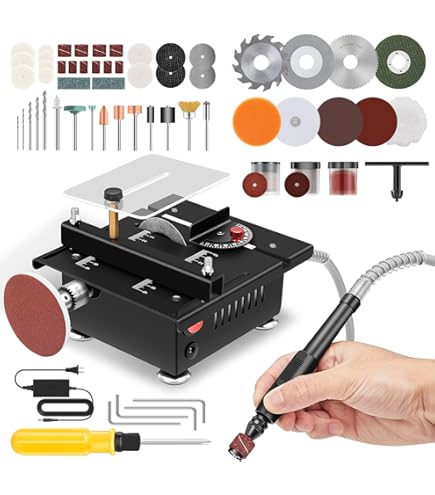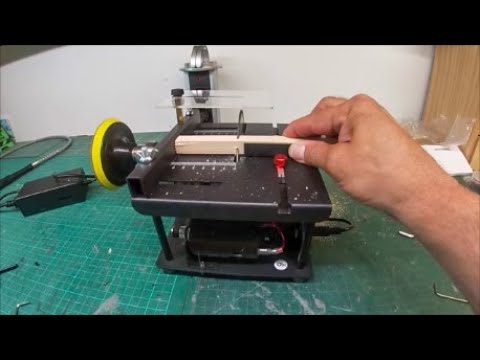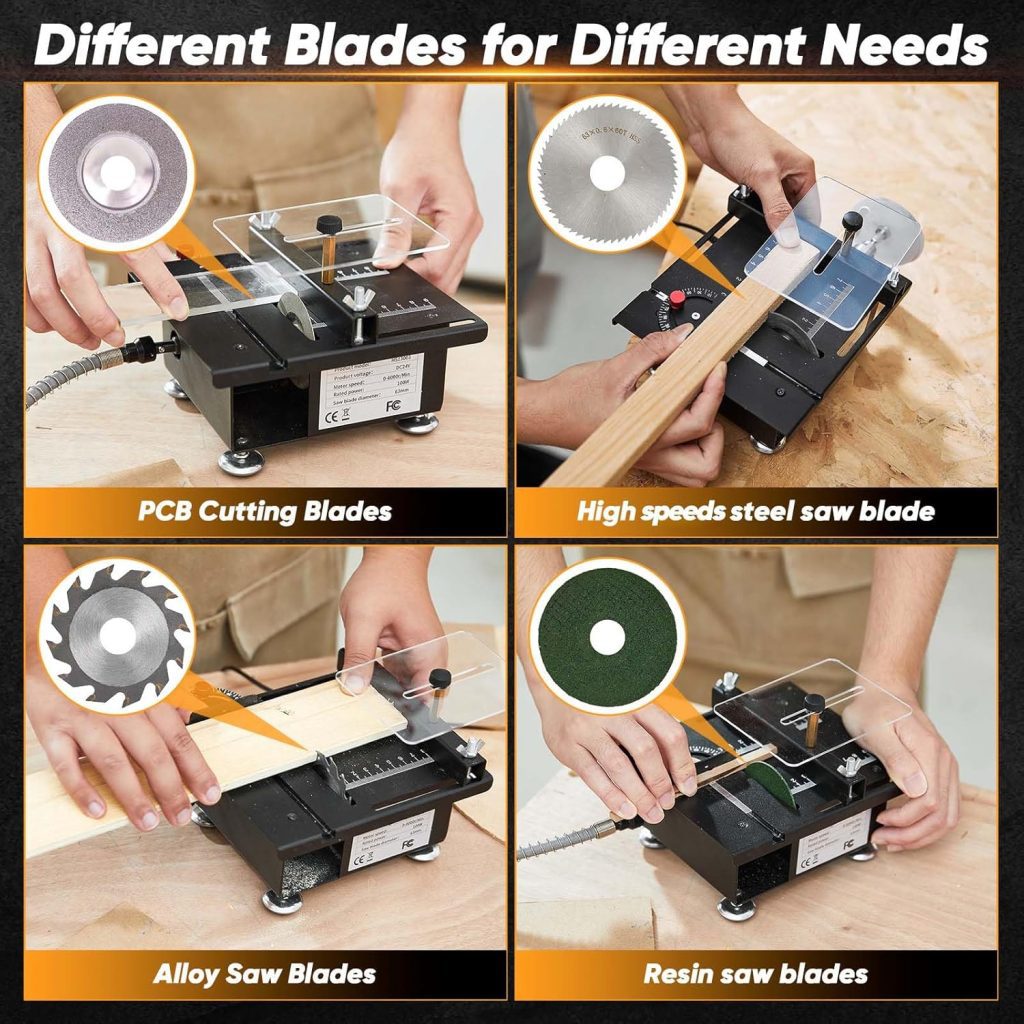Ever found yourself needing to make small, precise cuts for a craft project, model building, or a quick DIY fix, but a full-sized table saw felt like overkill? Or maybe you’re working in a tight space where a big, bulky power tool just isn’t an option. If that sounds familiar, you’ve probably stumbled across tools like the Saker Mini Multi-Functional Table Saw.
These compact power tools promise versatility and precision in a small package. But do they deliver? In this comprehensive Saker Mini Multi-Functional Table Saw review, we’re going to slice through the hype. We’ll look at its features, performance, who it’s really for, and whether it deserves a spot on your workbench.
What Exactly is the Saker Mini Multi-Functional Table Saw?

First things first, let’s clarify what we’re talking about. The Saker Mini Multi-Functional Table Saw is, as the name suggests, a small-scale table saw. It’s designed for light-duty cutting tasks on materials like thin wood (balsa, basswood, thin plywood), plastics, soft metals (like aluminum), and PCBs (Printed Circuit Boards).
Think of it as the nimble cousin to the heavy-duty workshop table saw. Its main appeal lies in its:
- Compact size: Easy to store, easy to move.
- Portability: You can take it almost anywhere.
- Versatility (claimed): Often comes with different blades for various materials.
- Precision for small items: Ideal for tasks where larger saws are too cumbersome.
It’s primarily marketed towards hobbyists, model makers, crafters, and DIY enthusiasts who need a tool for intricate work rather than heavy construction.
Unboxing and First Impressions: A Closer Look at the Saker Mini Saw

When my Saker Mini Saw arrived, the box was predictably small. Inside, you’ll typically find:
- The Saker Mini Table Saw unit itself.
- A power adapter.
- One or more saw blades (often a general-purpose HSS blade, and sometimes others for specific materials).
- A miter gauge.
- A blade guard (crucial for safety!).
- Allen keys or wrenches for blade changes.
- An instruction manual.
My initial impression was that it’s definitely a “mini” tool. The construction is generally a mix of metal (often aluminum for the table) and durable plastic for the housing. It feels relatively sturdy for its size, but you immediately understand this isn’t for cutting 2x4s. The focus is clearly on portability and small-scale projects.
The setup is usually straightforward: attach the blade, plug it in, and you’re almost ready to go. However, I always recommend carefully reading the manual, especially regarding blade installation and safety features.
Key Features and Specifications: What Makes the Saker Tick?
Let’s break down what this little machine offers. Features can vary slightly depending on the exact model or bundle, but here are the common highlights:
Compact Size and Portability
This is its biggest selling point. Often measuring around 7-10 inches in length and width, it can sit on a small desk or workbench without hogging space. Weighing just a few pounds, moving it around is a breeze. This is a huge plus for apartment dwellers or those with limited workshop areas.
Motor Power and Cutting Performance
The motors in these mini saws are, understandably, not powerhouse beasts. They are typically low-wattage, high-RPM motors. This means they can spin the small blades fast enough to cut through appropriate materials, but they will bog down if you push them too hard or try to cut something too thick or dense. We’re talking precision over brute force.
Blade Versatility

Most Saker Mini Table Saws come with at least one High-Speed Steel (HSS) blade, suitable for wood and plastic. Some packages might include diamond blades for harder materials like thin ceramics or PCBs, or even abrasive discs. The ability to swap blades adds to its “multi-functional” claim. Blade diameter is usually around 2 to 4 inches.
Included Accessories
- Miter Gauge: Essential for making angled cuts (crosscuts). The quality of these can vary, but even a basic one is better than none for achieving consistent angles.
- Blade Guard: A non-negotiable safety feature. It helps prevent accidental contact with the spinning blade and can deflect some debris.
- Rip Fence (sometimes): Some models might include a small rip fence for making straight cuts parallel to the blade. This is a very useful addition if present.
Safety Considerations
Safety is paramount with any power tool, no matter its size. The Saker mini saw typically includes:
- A transparent blade guard.
- A power switch that’s hopefully easy to access in an emergency.
However, due to its small size, you must be extra vigilant. Always use push sticks for small pieces, wear safety glasses, and keep fingers well away from the blade.
Here’s a quick look at typical specifications you might find:
| Feature | Typical Specification | Notes |
| Motor Power | 80W – 100W | Varies; adequate for light-duty tasks. |
| No-Load Speed | 4000 – 10000 RPM | High RPM helps with smoother cuts on thin items. |
| Max Cutting Depth | 1/2 inch to 1 inch (approx. 12-25mm) | Depends on blade size and material. |
| Blade Diameter | 2 inches – 4 inches (approx. 50-100mm) | Smaller blades for finer work. |
| Table Size | Approx. 7″x6″ to 10″x8″ | Compact footprint. |
| Power Source | Typically DC (via AC adapter) | Low voltage is common. |
| Weight | 2 lbs – 5 lbs (approx. 1-2.3 kg) | Very portable. |
Disclaimer: Specifications can vary between Saker models and sellers. Always check the specific product listing.
Where To Buy Saker Mini Multi-Functional Table Saw?
You Can Buy Saker Mini Multi-Functional Table Saw From Amazon directly :
Saker Mini Multi-Functional Table Saw,Mini Table Saws for Crafts,Portable Mini Desktop Electric Saw for Wood Cutting,Speeds & Angle Adjustable with More Accessories for Plastic Acrylic Cutting
- 【Multi-functional Mini Table Saw】Saker mini table saw is specifically designed for cutting small items and is compatible with materials such as PCB boards, wooden sticks, plastic sheets, thin wooden boards, cans, copper-clad panels, aluminum tubes, and copper tubes. Saker mini multi-functional table saw comes with 4 different types of circular saw blades to meet various cutting needs: PCB cutting blades, high-speeds steel saw blades, alloy saw blades, and resin saw blades. The saw blade size is 63 millimeters in diameter with a 16-millimeter inner hole.
- 【Powerful Motor and Adjustable Speeds】Powered by a 90W pure copper motor, Saker electric desktop saws operates at speeds up to 5000 rpm.Saker table saw stand features 5 adjustable speeds settings, making precise, efficient, and fast-cutting operations easy to achieve.
- 【Adjustable Cutting Angle】Adjustable cutting angle from 0° to 90°. Sawing depth of 16 mm. The desired angle of cut can be adjusted at will. In addition to cutting, Saker mini table saw can also be used for sanding, engraving and other fine manual work.
New starting from: 109.99
Go to AmazonPutting it to the Test: My Experience with the Saker Mini Table Saw
Okay, theory is one thing, but how does this miniature table saw actually perform? I put it through its paces with a few common hobbyist materials.
Setting Up the Saw
Setup was quick. The blade change mechanism is usually simple, involving an Allen key or a small wrench. Calibrating the miter gauge (if yours allows for fine adjustment) is a good idea for accuracy. The power cord is typically a bit short, so an extension cord might be handy.
Making Cuts: Precision and Ease of Use
I started with some thin balsa wood (1/8 inch). The Saker mini saw sliced through it cleanly and easily. The small blade left a relatively smooth edge. Using the miter gauge for 90-degree and 45-degree cuts was straightforward, though the gauge itself can feel a bit flimsy on some models. Precision is achievable, but you need a gentle touch.
Next, I tried some thin craft plywood (1/4 inch). Here, the motor started to show its limits. You need to feed the wood slowly and steadily. Pushing too hard will cause the blade to bind or the motor to slow down significantly. It got the job done, but patience is key.
I also tested it on acrylic sheets (1/8 inch). With the standard HSS blade, it cut, but the edge wasn’t perfectly clean – a bit of melting can occur. A blade specifically designed for plastics would likely yield better results.
What It Excels At
- Small, intricate cuts: Perfect for model airplane ribs, dollhouse furniture, small picture frames, or cutting precise strips from thin stock.
- Softwoods and thin plastics: Balsa, basswood, thin PVC sheets, and similar materials are its bread and butter.
- Portability: Taking it to a craft fair or a friend’s house for a collaborative project is no issue.
- Beginner-friendly (with caution): Its lower power can be less intimidating than a full-sized saw, but safety rules still apply rigorously.
Where It Falls Short
- Hardwoods or thick materials: Don’t even think about it. This saw is not designed for oak, maple, or anything thicker than its recommended capacity. You’ll burn out the motor or get very poor results.
- Heavy-duty use: It’s not built for continuous, demanding work. It’s a hobby tool, not an industrial one.
- Dust collection: Most models have minimal to no dust collection. Expect a bit of a mess, especially when cutting wood. Working in a well-ventilated area or using a small shop vac nearby is advisable.
- Accuracy out-of-the-box: You might need to spend some time squaring up the miter gauge or fence (if included and adjustable) to get truly precise cuts. Don’t expect machinist-level precision without some tinkering.
Who is the Saker Mini Multi-Functional Table Saw Best For?

This is a crucial question. The Saker mini table saw isn’t for everyone. It shines for specific users:
- Model Builders: (Trains, planes, ships, architectural models) – For cutting small, precise components from thin wood or plastic, it’s a great asset.
- Crafters: (Jewelry makers, miniature artists, dollhouse enthusiasts) – If your craft involves small-scale cutting of delicate materials, this saw can save a lot of time compared to manual methods.
- DIYers with light tasks: Need to trim a small piece of plastic, cut a thin dowel, or make a small repair? It can be handy.
- Electronics Hobbyists: For cutting PCB blanks or small project enclosures (if using an appropriate blade).
- Those with very limited space: If a regular table saw is out of the question due to space, this offers a powered cutting solution.
It’s NOT for:
- General woodworking or carpentry.
- Cutting firewood (obviously!).
- Anyone needing to cut materials thicker than about 1/2 to 3/4 inch regularly.
- Those who need extreme, consistent accuracy without any setup or calibration.
Pros and Cons: A Balanced View of the Saker Miniature Saw
Let’s sum up the good and the not-so-good:
Pros:
- Highly Portable and Compact: Easy to store and transport.
- Affordable: Generally much cheaper than full-sized table saws.
- Good for Intricate Cuts: Excels at small, detailed work on thin materials.
- Relatively Quiet: Compared to larger power tools, the noise level is more manageable.
- Versatile with Blade Changes: Can handle different materials if you have the right blades.
- Low Power Consumption: Doesn’t draw a lot of electricity.
Cons:
- Limited Cutting Power & Capacity: Struggles with hard or thick materials.
- Build Quality Varies: Some components (like miter gauges) can feel flimsy.
- Accuracy May Require Tuning: Might need adjustments for precise results.
- Safety Concerns: Small size means fingers can get close to the blade; requires utmost care.
- Poor Dust Collection: Can be messy to operate.
- Not for Heavy-Duty Use: It’s a hobby-grade tool.
Tips for Getting the Most Out of Your Saker Mini Table Saw
If you decide this tool is for you, here are a few tips:
- Safety First, Always: Wear safety glasses. Use push sticks for small pieces. Keep your fingers clear. Unplug before changing blades or making adjustments.
- Choose the Right Blade: Using a blade meant for wood on metal won’t work well and can be dangerous. Invest in appropriate blades for your common materials.
- Slow and Steady Wins the Race: Don’t force materials through the saw. Let the blade do the work. A slow, consistent feed rate yields better cuts and is safer for the motor.
- Secure Your Workpiece: Ensure the material is stable and properly guided, especially when not using a fence or miter gauge (though using them is highly recommended).
- Regular Cleaning: Dust and debris can build up. Keep the saw clean for optimal performance and longevity.
- Know Its Limits: Understand what the saw can and cannot do. Pushing it beyond its capabilities will lead to frustration and potential damage.
- Consider Upgrades (if possible): Some users create custom jigs or replace the stock miter gauge with something more robust for better accuracy.
Alternatives to Consider
If the Saker mini saw doesn’t sound quite right, or if you need a bit more oomph or a different type of cutting, consider these:
- Scroll Saw: Excellent for intricate curves and internal cuts in thin wood.
- Band Saw (benchtop model): More powerful, can cut thicker materials and curves.
- Rotary Tool (like Dremel) with cutting attachments: Versatile for very small, freehand cuts, grinding, and polishing.
- Manual Hand Saws (e.g., Japanese pull saws, coping saws): Offer great control for fine woodworking, no power needed.
- Larger Benchtop Table Saws: If you have the space and need to cut thicker stock more regularly.
The Verdict: Is the Saker Mini Multi-Functional Table Saw Worth Your Money?
After a thorough look, my Saker Mini Multi-Functional Table Saw review concludes this: it’s a niche tool that can be incredibly useful for the right person.
If you are a hobbyist, model maker, or crafter working primarily with thin, soft materials and needing precise, small cuts in a compact package, then YES, the Saker Mini Table Saw can be a worthwhile investment. It offers a level of convenience and precision for these tasks that’s hard to beat for the price and size.
However, if you’re looking for a general-purpose woodworking saw, or need to cut anything substantial in terms of thickness or hardness, then NO, this is not the tool for you. You’ll be frustrated by its limitations and would be better off investing in a more robust saw.
It’s all about managing expectations. Understand what this miniature table saw is designed for, respect its limitations, and prioritize safety. If your projects align with its strengths, it can be a surprisingly handy addition to your toolkit.
Frequently Asked Questions (FAQ) about the Saker Mini Table Saw
Here are some common questions people ask:
Q1: What materials can the Saker mini multi-functional table saw cut?
- A1: It’s best for thin, soft materials like balsa wood, basswood, thin plywood (up to about 1/4 inch), plastics (like acrylic or PVC sheets), and with the correct blade, soft metals like thin aluminum or PCBs. It’s not suitable for hardwoods or thick stock.
Q2: Is the Saker mini table saw safe for beginners to use?
- A2: While its lower power might seem less intimidating, any table saw requires extreme caution. Beginners can use it, but they MUST thoroughly understand safety procedures, use all guards, wear eye protection, and use push sticks. Adult supervision is recommended for younger users.
Q3: How deep can the Saker mini table saw actually cut?
- A3: The maximum cutting depth typically ranges from 1/2 inch to about 1 inch (12mm to 25mm), depending on the specific model and blade diameter. However, performance is best on materials well below this maximum.
Q4: Where can I buy the Saker mini multi-functional table saw?
- A4: Saker tools, including this mini table saw, are often sold online through major e-commerce platforms like Amazon, eBay, AliExpress, or directly from Saker’s website or affiliated retailers.
Q5: Can I use different brands of blades on the Saker mini saw?
- A5: Yes, as long as the replacement blade has the correct arbor size (the hole in the center) to fit the saw’s spindle and the blade diameter is compatible with the saw’s guard and cutting capacity. Always check these specifications.
I hope this detailed review of the Saker Mini Multi-Functional Table Saw helps you decide if it’s the right tool for your creative endeavors. Happy making, and always stay safe!

Finlay Connolly is a woodworking enthusiast and power tool specialist with over a decade of hands-on experience in the workshop. As the founder and lead writer at ProTableSawReviews.com, Finlay combines expert knowledge with real-world testing to help woodworkers, DIYers, and professionals choose the best tools for the job. With a sharp eye for detail and a passion for precision, Finlay is committed to providing trustworthy, practical advice backed by years of experience and research in the field. Whether you’re cutting dados or comparing fence systems, you can count on Finlay for honest, reliable reviews that make your next cut your best one.

